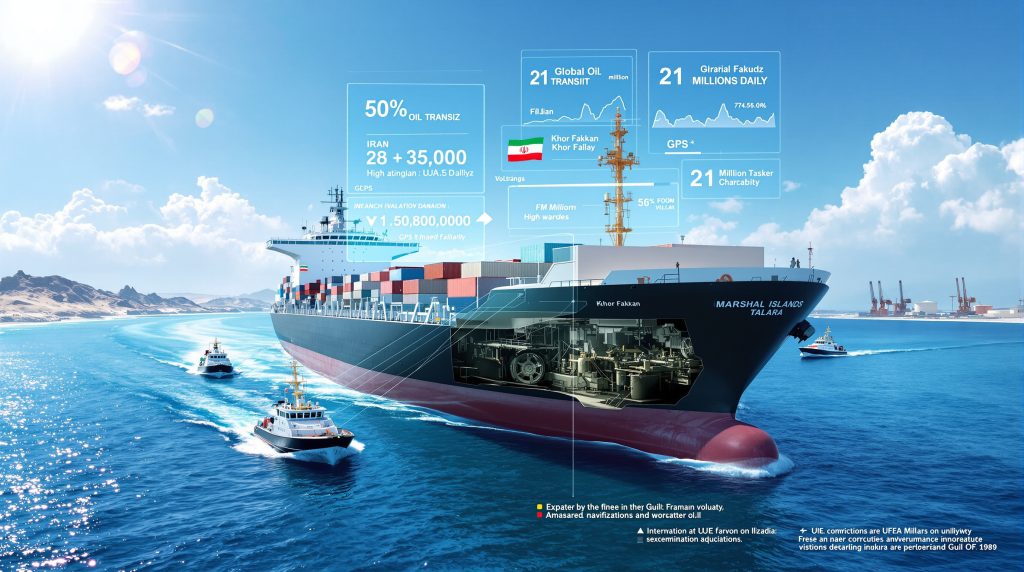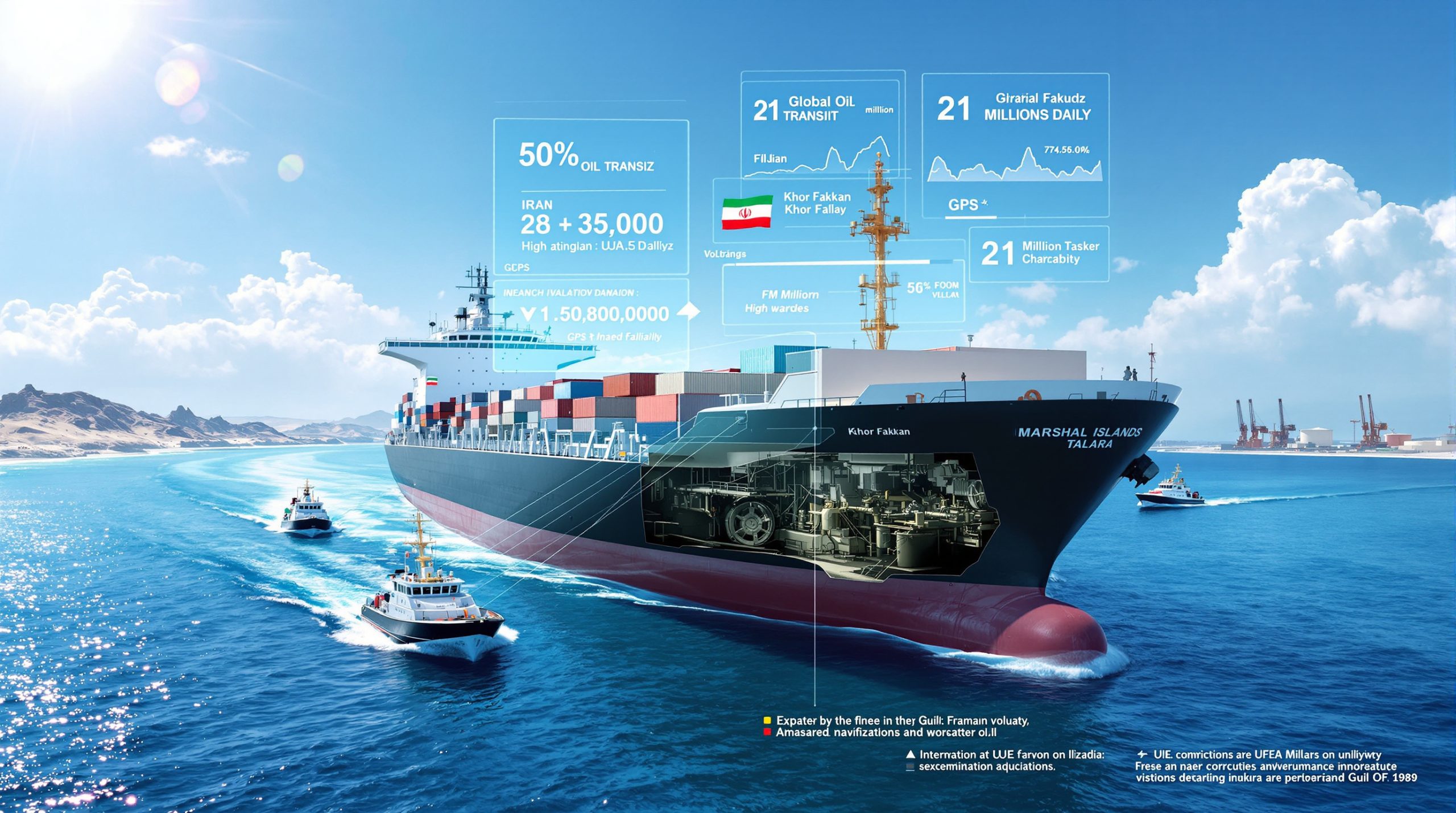Understanding the Maritime Incident That Shook Global Energy Markets
The seizure of an oil tanker by Iranian forces in the Gulf of Oman on November 14, 2025, represents a significant escalation in regional maritime tensions that sent ripples through global energy markets. This Iran seizes oil tanker in Gulf of Oman incident occurred in one of the world's most strategically important shipping corridors, where approximately 21% of global petroleum liquids transit daily through the narrow Strait of Hormuz chokepoint.
Key Details of the Vessel Interdiction
The Marshall Islands-flagged tanker Talara, weighing 73,371 tons, was intercepted by three Iranian military vessels approximately 20 nautical miles east of Khor Fakkan in the UAE. According to maritime security firm Ambrey, the Iranian boats attached themselves directly to the vessel's hull, forcing an abrupt course change into Iranian territorial waters.
The ship, operated by Cyprus-based Columbia Shipmanagement, was carrying high-sulfur gas oil loaded from the UAE's Hamriyah port and destined for Singapore. Furthermore, this oil market volatility demonstrates the fragile nature of energy transportation security.
The incident was documented by a U.S. Navy MQ-4C Triton surveillance drone, while British maritime authorities issued immediate navigation warnings for the region. Defense officials confirmed Iranian state involvement, marking this as the first Iranian interdiction of a commercial vessel not involved in fuel smuggling since April 2024. However, such incidents involving tanker seizures have become increasingly common in regional waters.
How Do Iranian Tanker Seizures Impact Global Oil Markets?
Immediate Market Response and Price Volatility
Following the seizure announcement, oil markets experienced notable fluctuations, with ICE Brent crude recovering to $64 per barrel after initially declining. However, the price impact remained limited due to broader bearish sentiment affecting energy markets. In addition, the incident's timing coincided with revised supply forecasts from major international energy agencies that predicted significant oversupply conditions for 2026.
According to market analysis, the International Energy Agency had recently revised its 2026 outlook, lifting supply growth projections to 2.5 million barrels per day while reducing demand growth to just 770,000 barrels per day. This revision suggests a potential surplus of 4.1 million barrels per day in 2026, equivalent to approximately 4% of global crude demand.
Strategic Importance of Maritime Chokepoints
| Transit Metrics | Daily Volume | Global Share |
|---|---|---|
| Crude Oil Transit | ~21 million barrels | 21% of global petroleum |
| LNG Shipments | Major regional flows | 25% of global LNG trade |
| Economic Value | $1.2+ billion daily | Critical energy security |
| Waterway Width | 21 miles (narrowest) | Single point vulnerability |
The Strait of Hormuz serves as the world's most critical energy transportation chokepoint, making any disruption a matter of immediate international concern. This narrow waterway represents the sole maritime route for Persian Gulf oil exports to reach global markets, consequently making energy security strategies crucial for maintaining global supply stability.
What Are the Geopolitical Implications of Maritime Seizures?
Regional Tensions and International Response
This seizure marks a significant escalation in Iranian maritime strategy, representing the first such incident involving a commercial vessel not engaged in fuel smuggling activities for over 19 months. The timing appears particularly significant, occurring several months after heightened regional tensions following conflicts between Iran and Israel in June 2025.
International Response Coordination:
- U.S. naval surveillance assets documented the incident in real-time
- British UKMTO issued immediate navigation warnings for regional shipping
- Defense officials across multiple nations confirmed Iranian state involvement
- Maritime security firms elevated threat assessments for the region
Historical Patterns of Iranian Maritime Actions
Iran has historically employed tanker seizures as diplomatic leverage during periods of international pressure, particularly when facing enhanced sanctions or regional isolation. These actions typically target vessels operating in international waters near Iranian territorial boundaries, creating complex legal situations that require diplomatic rather than military resolution.
The pattern suggests Iranian maritime actions serve multiple strategic purposes: demonstrating naval presence, pressuring international negotiators, and maintaining regional deterrence capabilities. For instance, previous incidents have often coincided with breakdown in nuclear negotiations, implementation of new sanctions, or escalation of regional military tensions.
Who Owns the Seized Tanker and What Was Its Cargo?
Vessel Ownership and Commercial Details
The Talara operates under a complex ownership structure typical of modern commercial shipping. The vessel is owned by Pasha Finance, a Limassol-based company controlled by Azerbaijan's Aliyev family interests. This ownership arrangement adds significant diplomatic complexity to resolution efforts, potentially involving Azerbaijani government interests alongside traditional vessel operator concerns.
Detailed Cargo Specifications:
| Parameter | Specification | Commercial Details |
|---|---|---|
| Product Type | High-sulfur gas oil | Marine fuel/heating oil |
| Volume | Approximately 2 million litres | Partial vessel capacity |
| Loading Port | Hamriyah, UAE | October 2025 loading |
| Destination | Singapore | Regional fuel hub |
| Estimated Value | $50-70 million | Based on current pricing |
The cargo represents a significant commercial shipment of high-sulfur gas oil, a product commonly used for marine fuel and heating applications. Furthermore, the estimated value reflects current market pricing for petroleum products in the Persian Gulf to Southeast Asia trade route.
Operational Structure and Flag State Implications
Columbia Shipmanagement, the Cyprus-based operator, manages day-to-day vessel operations, crew management, and commercial activities. The Marshall Islands flag creates specific jurisdictional complexities, as resolution requires coordination between multiple parties across different legal frameworks.
This fragmented ownership structure is standard in modern maritime commerce but complicates seizure negotiations. Consequently, resolution typically requires consent from beneficial owners, legal owners, operators, flag states, and potentially port authorities where cargo was loaded.
How Do Maritime Security Firms Monitor Gulf Waters?
Advanced Surveillance and Threat Assessment
Maritime security organisations employ sophisticated monitoring systems combining satellite tracking, automated identification systems, and real-time communication networks to track vessel movements in high-risk areas. The UK Maritime Trade Operations (UKMTO) serves as a primary coordination centre, providing real-time security information to commercial vessels operating in Persian Gulf waters.
Security Protocol Enhancement: Modern tankers operating in these waters typically maintain enhanced communication systems, GPS tracking capabilities, and emergency response protocols to ensure continuous contact with operators and international maritime authorities during transit.
Industry Response to Elevated Regional Risks
Shipping companies have systematically adapted their operations through multiple security enhancements:
- Route diversification strategies to minimise exposure to high-risk areas
- Enhanced crew training protocols for emergency response situations
- Insurance adjustments reflecting elevated regional security risks
- Coordination mechanisms with international naval forces for convoy protection
The industry maintains specialised risk assessment capabilities that evaluate geopolitical developments, historical incident patterns, and current threat intelligence to guide operational decisions. However, these escalating Gulf tensions continue to challenge traditional security measures for vessels transiting the region.
What Does This Mean for Future Energy Transportation?
Long-term Implications for Critical Shipping Routes
The Iran seizes oil tanker in Gulf of Oman incident highlights persistent vulnerabilities in global energy transportation networks, particularly the continued dependence on narrow maritime chokepoints for substantial portions of international oil trade. Industry analysts suggest such incidents may accelerate discussions about developing alternative export terminals and enhanced international maritime security cooperation.
The incident demonstrates how geopolitical tensions can quickly impact energy transportation, even during periods of anticipated market oversupply. This dynamic suggests continued importance of supply chain diversification and security enhancement regardless of fundamental supply-demand balances.
Investment Impact on Energy Infrastructure
Anticipated Market Responses:
- Insurance premium increases for vessels transiting Persian Gulf routes
- Accelerated development of alternative export infrastructure outside chokepoint routes
- Enhanced adoption of maritime security technologies and monitoring systems
- Strengthened international cooperation on maritime patrol and escort operations
The incident reinforces the strategic importance of energy supply chain resilience and the continued need for international coordination in maintaining open sea lanes critical to global energy security. Moreover, the oil price rally following such incidents demonstrates the market's sensitivity to supply chain disruptions.
Regional Maritime Security Challenges
Evolving Threat Landscape
The Gulf of Oman incident occurs within a broader context of evolving regional security challenges. Maritime security experts note increasing sophistication in interdiction techniques and growing coordination between state and non-state actors in regional waters.
Recent patterns suggest maritime incidents are becoming more closely integrated with broader geopolitical strategies, rather than isolated tactical actions. This evolution requires enhanced international coordination and more sophisticated response mechanisms from both commercial operators and naval forces.
Insurance and Commercial Implications
The seizure will likely trigger immediate reviews of insurance coverage for vessels transiting the region. Protection and Indemnity (P&I) insurance rates and war risk premiums typically increase following such incidents, directly impacting shipping costs for energy transportation.
Commercial operators must balance route efficiency against security risks, often requiring real-time decision-making based on current threat assessments and insurance coverage availability. In addition, these decisions are increasingly influenced by trade war impacts on global shipping patterns.
Economic Impact Beyond Energy Markets
Broader Supply Chain Considerations
While the immediate focus centres on oil market impacts, the seizure affects broader supply chain confidence for goods transiting through Persian Gulf shipping lanes. Singapore, the intended destination for the seized cargo, serves as a major regional fuel distribution hub, making any disruption significant for Southeast Asian energy security.
The incident reinforces concerns about supply chain vulnerability in an increasingly interconnected global economy, where single-point failures can have cascading effects across multiple industries and regions. Furthermore, the OPEC production outlook plays a crucial role in determining how such supply disruptions affect global energy markets.
Diplomatic Resolution Mechanisms
Historical precedent suggests resolution of such incidents typically involves complex diplomatic negotiations rather than immediate release. The multi-jurisdictional ownership structure adds layers to potential resolution mechanisms, likely requiring coordination between Azerbaijani, Cypriot, Marshall Islands, and potentially UAE authorities.
Resolution timelines can vary significantly based on broader geopolitical conditions, concurrent international negotiations, and the specific objectives underlying the initial seizure decision.
Conclusion: Navigating Persistent Maritime Vulnerabilities
The Iran seizes oil tanker in Gulf of Oman incident underscores the enduring volatility inherent in Middle Eastern energy transportation networks. Despite forecasts of global oil oversupply, the incident demonstrates how geopolitical actions can quickly impact critical supply chains and highlight persistent vulnerabilities in international energy security infrastructure.
The limited immediate market impact reflects broader bearish sentiment in oil markets, yet the incident serves as a crucial reminder of the delicate balance between regional political dynamics and international energy flows. As global energy markets continue adapting to evolving supply-demand fundamentals, events like this emphasise the continued importance of maritime security in maintaining stable energy transportation.
Moving forward, stakeholders will likely focus on strengthening international maritime cooperation, enhancing security protocols, and developing more resilient supply chain alternatives. The incident reinforces the strategic imperative of maintaining open shipping lanes while building greater flexibility into global energy transportation networks.
The commercial and diplomatic complexities surrounding this seizure will likely influence future maritime security policies and international coordination mechanisms for protecting critical energy supply routes. Consequently, success in resolving this incident may establish important precedents for managing similar situations in an increasingly complex geopolitical environment.
Ready to Capitalise on Energy Market Volatility?
Discovery Alert's proprietary Discovery IQ model delivers real-time alerts on significant ASX mineral discoveries, including critical energy transition commodities, instantly empowering subscribers to identify actionable opportunities ahead of broader market reactions to global events. Begin your 30-day free trial today and secure your market-leading advantage in an increasingly volatile energy landscape.




